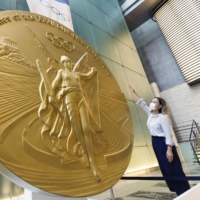While the 2020 Tokyo Olympics 開会式 (kaikaishiki, opening ceremony) will be remembered for a notable lack of spectators, the event reminded us that the 選手 (senshu, athletes) are at the real stars of the show.
As with previous Olympics, a major part of the media coverage is the daily updates of 国別メダル獲得数 (kunibetsu medaru kakutoku-sū, number of medals won by country). This is where you’ll find out which country is taking the 金 (kin, gold), 銀 (gin, silver) and 銅 (dō, bronze) メダル (medaru, medals).
While the verb 優勝する (yūshō suru, to win the top spot) tends to be used when someone has won a tournament — 白鵬が今年の大相撲七月場所で優勝した (Hakuho ga kotoshi no Ōzumo Shichi-gatsu Basho de yūshō shita, Hakuho won this year’s July Grand Sumo Tournament) — but the verb 獲得する (kakutoku suru, to acquire) is more often used when an athlete or national team wins an Olympic medal. In their verb forms, the kanji used for kaku and toku, 獲る and 得る, are both read “eru,” meaning to obtain or get.
As for the medals themselves, their 表 (omote, front) bears the words “Games of the XXXII Olympiad Tokyo 2020,” along with an image of the Parthenon in Athens, the five Olympic rings and an image of ニケ (Nike, pronounced “nee-kay”), the ancient winged Greek goddess of victory. On the medals’ 裏 (ura, reverse) are the symbol of the Tokyo Games, the words “Tokyo 2020” and the 五輪 (gorin, five rings) symbol.
When it comes to the kanji for 金, 銀 and 銅, the first thing you might notice is that the kanji for 金 (kin/kane, gold/money/metal) is replicated on the left side of the kanji for 銀 and 銅. That’s called the 金編 (kane-hen, metal radical), and when you see it in a kanji there’s a good chance the meaning of that word has to do with metal — 針 (hari, needle), 釘 (kugi, nail/spike) or 鍋 (nabe, cooking pot), for example.
金 is usually read “kin” when referring to gold. When read “kane,” however, it refers to money, not necessarily made of gold. These days, when referring to the precious metal, the word 純金 (junkin, pure gold) is usually preferred over 黄金 (ōgon, “yellow gold”) — though you may hear of 黄金時代 (ōgon jidai), the Golden Age.
金メッキ (Kin mekki) refers to gold plating, 金箔 (kinpaku) to gold leaf, and let’s not forget Egypt, famous for its ancient 金字塔 (kinjitō), towers shaped like the character 金, i.e. pyramids (though, nowadays people refer to them with the katakana-written ピラミッド [piramiddo]).
Along with 時は金なり (toki wa kane nari, time is money), there’s another astute saying that goes, 金の切れ目が縁の切れ目 (kane no kireme ga en no kireme), meaning relationships built on money will end when the money runs out.
Combine 銀 (gin, silver) with 行 (kō [adopted from “hong,” a Cantonese word for a trading house]), and you get 銀行 (ginkō) — a business that trades in silver, i.e., a bank. The famous district in Tokyo, 銀座 (Ginza) owes its name to the silver mints once located there.
銀 also appears in other words, including 水銀 (suigin, “water silver”), which refers to the element mercury. Polished white rice is sometimes called 銀シャリ (gin shari), and the Milky Way constellation is 銀河 (Ginga, “silver river”). Similar to English, 銀幕 (ginmaku) refers figuratively to the “silver screen” of cinema.
As for bronze, we find it in such words as 銅像 (dōzō, bronze statue) and 銅器時代 (dōki jidai, the Bronze Age). A 銅鑼 (dora, bronze gong), is a large metal disk struck with a mallet, commonly associated with Asia in Western B-movies from the 1930s. It also inspired the name of popular confection called どら焼き (dorayaki), a sandwich of two small sweet pancakes filled with red bean paste.
Let’s take a look at a few of Japan’s 歴代のメダリスト (rekidai no medarisuto, historical/past medalists). The first Japanese athlete to receive a medal at an Olympics was 熊谷一弥 (Kumagai Ichiya, Ichiya Kumagae [he went with an “e” in English), who was awarded a 銀メダル in the men’s tennis competition at the 1920 Antwerp Games.
Next are 日本人金メダリストの最年長、最年少 (Nihonjin kin medarisuto no sainenchō, sainenshō, oldest and youngest Japanese gold medalists). The oldest was 蒲池猛夫 (Kamachi Takeo, Takeo Kamachi), who won the 男子ラピッドファイアピストル (danshi rapiddo faia pisutoru, men’s 25 meter rapid fire pistol) event at the Los Angeles Olympics in 1984, at the age of 48 years and 135 days. As of this week, the youngest is 西矢椛 (Nishiya Momiji, Momiji Nishiya). She took the gold medal in スケートボード女子ストリート (sukētobōdo joshi sutorīto, women’s street skateboarding) at the tender age of 13 years, 10 months and 26 days.
In terms of total medals won prior to the current Games, 日本の夏季オリンピックの獲得メダル数は441個 (Nihon no kaki Orinpikku no kakutoku medaru-sū wa 441-ko, the number of medals won by Japan at summer Olympics is 441). To paraphrase a Japanese saying, 金が全てではない (kin ga subete dewa nai, gold isn’t everything).
In a time of both misinformation and too much information, quality journalism is more crucial than ever.
By subscribing, you can help us get the story right.
SUBSCRIBE NOW



